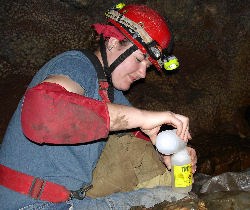
NPS Photo There are over 50 places inside Jewel Cave where water drips from the ceiling, and a few isolated places where this water has collected in pools. All of the water inside the cave comes from the surface, and all activities above the cave can have a dramatic effect on water in the cave below. Road salts, chemicals, sewer lines, and fuel and oil from vehicles all have the potential to impact water quality inside the cave. At Jewel Cave National Monument, a monthly monitoring program checks the water quality at several drip sites in the cave. Elevated chloride levels that have been discovered at some sites most likely point to the use of salts to de-ice roads. Due to water quality concerns, the park management is very cautious when deciding whether or not to use chemicals above the cave. Such decisions are based on the best available science, and consider such factors as soil depth and composition, geology, and hydrology. For example, chemicals cannot be used to kill noxious weeds in most areas of the park because the cave is vulnerable to infiltration of pesticides. To protect water quality, the park relies primarily on manual control of exotic plants (hand pulling and cutting). |
Last updated: June 5, 2021
